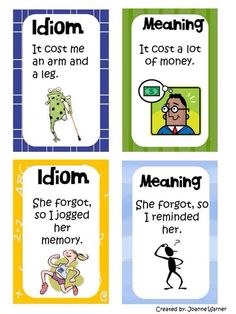a. Idiom
What is idiom? Idiom comes from the
Greek idios, which means personal. Idiom originally meant
"speech peculiar or proper to a people or country." In linguistic,
idiom is the meaning that you are expected to understand is different from what
the words should mean. We need idioms because they
were coined to communicate a specific and usually quite precise meaning for
which there is no exact word. Idioms are a type of figurative language
that plugs the gaps in our vocabulary.
Where do idioms
come from? Idioms often come from jargon. 'Jargon' is the
language that any group of people who work together in a particular subject
develop for themselves. Sometimes these expressions 'escape' into the general
language, often with their meaning considerably changed. However, the modern
idiom means almost the opposite - something which is very hard to get to
understand.
Why we should learn idiom? Because you will
not understand English until you do. Some British sports commentators seem to
speak only in idioms. While learning idioms is difficult because of their
non-literal meaning, it will give you a much richer understanding of the
English language and culture.
Why are idioms
used?
Idioms are a part of language (and not just a part of English). They give a
meaning more vividly and often more briefly than a long literal explanation
would do. Also because there is such a huge number of idioms to choose from, a
person's choice of idioms tells you much about that person's character and
origins.
Types of idiom :
1.
Idiom Penuh
Idiom penuh adalah idiom yang
unsur-unsurnya secara keseluruhan sudah merupakan satu kesatuan dengan satu
makna,
atau dengan kata lain idiom penuh merupakan ungkapan/idiom yang unsur-unsur
pembentuknya telah kehilangan makna leksikanya.
For example :
-
Gulung tikar =
Bangkrut
Analisis makna leksikalnya :
·
Gulung memiliki
arti lipatan benda
·
Tikar memliki
arti anyaman pandan
-
Kambing hitam =
Orang yang dituduh atau bersalah
Analisis makna leksikalnya :
·
Kambing
memiliki arti nama hewan.
·
Hitam memiliki
arti salah satu jenis warna
2. Semi Idiom
Semi idiom atau idiom sebagian
adalah idiom yang salah satu unsur pembentuk masih memiliki makna leksikalnya.
For example :
-
Lapangan hijau
= Lapangan sepak bola
Analisis makna leksikalnya :
·
Lapangan memiliki
arti tempat atau tanah yang luas
·
Hijau memiliki
arti salah satu jenis warna
-
Koran kuning =
Koran sensasi
Analisis makna leksikalnya :
·
Koran memiliki
arti surat kabar atau berita
·
Kuning memiliki
arti salah satu jenis warna
b.
Symbol Reference
What
is symbol reference? As we know, symbol reference is two words that have
meaning. Symbol means something that
represents something else. And reference is the relationship of one
linguistic expression to another, in which one provides the information
necessary to interpret the other. So, symbol reference is the symbolic
relationship that a linguistic expression has with the concrete object or
abstraction it represents.
On
Indonesian Dictionary by WS Poerwadarminta said that symbol is like sign,
portrait, expression, badge, and etc, which say something or have specific
purpose.
This
is example of symbol references.
References :





Thanks for share. Train the Trainer Course
BalasHapus